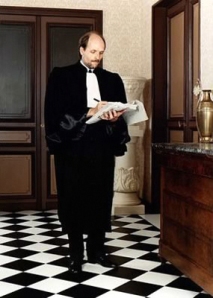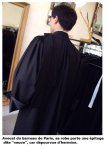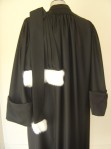
toge d’avocat from http://www.petit-costumesaudiences.com/barreau.html
I’ve been wanting to do this for a while….
One thing that the US legal system (and a few others lack) is Court Dress, that is the style of clothes prescribed for courts of law. Technically, one is supposed to wear a morning coat to the US Supreme Court (no analogue for women) and a suit to lower courts, but that isn’t the same as robes. The court dress of judges and practicing lawyers in the North American colonies which would become the United States closely mirrored British court dress of the 18th century; both wore white powdered wigs and (typically) black robes in the lower courts, and in the higher ones, judges would wear red with black markings.
The official portrait of the first chief justice of the US Supreme Court, John Jay, shows him in a robe of black and red with white borders. There is a story, perhaps apocryphal, is that Thomas Jefferson himself objected to such unnecessary pomp: As an ardent supporter of modest republican citizenship, Jefferson was against “any needless official apparel,” especially “the monstrous wig which makes the English judges look like rats peeping through bunches of oakum.”
The practice of wearing court dress for lawyers in the US fell out of favor and died out by the mid-nineteenth century. Although, I am not sure what would happen if one were to show up in an English Barrister’s robe in a US court. The reaction might depend on the judge.
Even the UK is beginning to see court dress become optional, court dress being dispensed with at the option of the judge, e.g. in very hot weather, and invariably where it may intimidate children, e.g. in the Family Division and at the trials of minors. It is also not worn at hearings in chambers and in the magistrates’ courts in the UK.
Supposedly, the tradition of court dress comes from the robes worn by the clergy since lawyers were part of the educated classes. Although, I have also heard they came from knights and trial by ordeal. Although, the clerical and
educated explanation makes a bit more sense: especially when one considers that the French toge d’avocat has a closed front with 33 buttons (the age when Jesus Christ was supposed to have died). One thing which is common between civil and common law robes is the hood, or épitoge.
The US at one time had court dress, but that faded away post War for Independence with even robes being dispensed, which is a shame. Canada seems to still have robes with a choice between Common-Law Style and Civil Law style, which is amusing since civil law actually came about with Napoleon Bonaparte (50 years after Canada became a British territory). My personal preference is for the Civil Law, or Continental, style  since it has a closed front and can pretty much cover what is worn underneath. Although, forget wearing shorts since they are not that long, but one could wear chinos underneath it.
since it has a closed front and can pretty much cover what is worn underneath. Although, forget wearing shorts since they are not that long, but one could wear chinos underneath it.
I am using a French robe d’avocat or toge d’avocat as an example of the Civil law style since it is pretty much what would be worn in either Belgium or France. The Italian version is jazzier with gold trim and the German version looks like a US judge’s robe. The épitoge on a non-Parisian toge has fur (either Ermine or Rabbit). A Parisian épitoge doesn’t have the fur and is called a “veuve”. I was given various explanations about the hood on the barrister’s robe when I was a pupil: it held potpourri because people stank or that was where you put the money since barristers were not expected to discuss remuneration. I think the real explanation is that both the hood and the épitoge are remnants of the hood on a medieval robe.
One can debate the utility of wearing court dress, but I like to think that it adds to the legal process. Also, robes, especially the Civil law ones, can be more of an equaliser than wearing “civilian clothes” to court.
See also:
- Justice Sandra Day O’Connor on Why Judges Wear Black Robes
- Ede and Ravenscroft
- A history of court dress at Ede and Ravenscroft
- Why do barristers wear robes?
- Histoire, fondements et réglementation de la robe d’avocat.
- Barreau de Paris: une épitoge des avocats spécial
- Pourquoi les avocats portent-ils une robe ?

